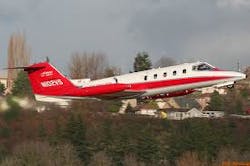Northrop Grumman and U.S. Navy test autonomous aerial refueling for unmanned combat air system
ST. AUGUSTINE, Fla., Jan. 26, 2012. Northrop Grumman Corporation (NYSE:NOC) and the U.S. Navy have completed a series of flight tests to demonstrate technology that could help extend the operating range and flight duration of future carrier-based unmanned systems. The flight tests, completed Jan. 21 in St. Augustine, proved the functionality of the hardware and software that will enable the X-47B unmanned aircraft to demonstrate autonomous aerial refueling (AAR) in 2014. The AAR activity is part of the Navy's Unmanned Combat Air System Carrier Demonstration (UCAS-D) program. Northrop Grumman is the Navy's UCAS-D prime contractor.
The AAR tests were conducted by a Northrop Grumman/Navy team using Calspan Corporation's (Niagara Falls, N.Y.) Variable Stability Learjet as the X-47B surrogate aircraft, and a K707 tanker provided by Omega Air Refueling (Alexandria, Va.). The tests included simulated flight demonstrations of both boom/receptacle and probe-and-drogue aerial refueling techniques. No fuel was exchanged between the aircraft during the test events, however.
The Learjet surrogate was equipped with functional equivalents of the navigation systems, flight control processor and vision system that the X-47B will use to conduct refueling operations. The aircraft contained no refueling receptacle or refueling probe. The K707, which is nearly identical in size and shape to an Air Force KC-135, was equipped with a Navy style refueling drogue only.
For each simulated refueling event, the Learjet/X-47B surrogate was piloted to a rendezvous position approximately one nautical mile from the tanker. Then the pilot transferred control of the aircraft to the X-47B's autonomous flight control processor, which controlled the Learjet during the test event.
During a typical refueling event, the tanker operator or a mission operator on the ground commanded the Learjet to fly, in sequence, to each of the major positions associated with aerial refueling: (1) the pre-tanking observation point off one wing of the tanker; (2) the refueling contact position behind the tanker; and (3) the post-tanking "reform" position off the other wing of the tanker.
The Northrop Grumman/Navy test team plans to conduct additional AAR surrogate testing using the same aircraft when flight-qualified versions of the relevant X-47B hardware and software become available.
The UCAS-D program plans to demonstrate in 2013 the ability of the tailless, autonomous, low-observable relevant X-47B demonstrator to safely operate from a Navy aircraft carrier, including launch, recovery, bolter and wave-off performance, followed by the autonomous aerial refueling in 2014. The program also plans to mature technologies required for potential future Navy unmanned air system programs.



